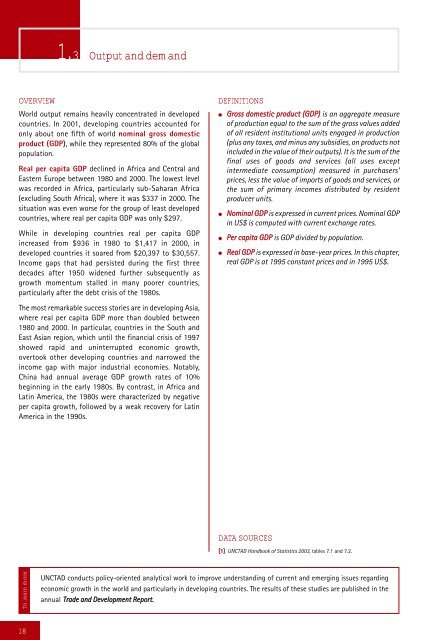Development and Globalization: - Unctad
Development and Globalization: - Unctad
Development and Globalization: - Unctad
Create successful ePaper yourself
Turn your PDF publications into a flip-book with our unique Google optimized e-Paper software.
18<br />
1.3 Output <strong>and</strong> dem<strong>and</strong><br />
OVERVIEW DEFINITIONS<br />
World output remains heavily concentrated in developed<br />
countries. In 2001, developing countries accounted for<br />
only about one fifth of world nominal gross domestic<br />
product (GDP), while they represented 80% of the global<br />
population.<br />
Real per capita GDP declined in Africa <strong>and</strong> Central <strong>and</strong><br />
Eastern Europe between 1980 <strong>and</strong> 2000. The lowest level<br />
was recorded in Africa, particularly sub-Saharan Africa<br />
(excluding South Africa), where it was $337 in 2000. The<br />
situation was even worse for the group of least developed<br />
countries, where real per capita GDP was only $297.<br />
While in developing countries real per capita GDP<br />
increased from $936 in 1980 to $1,417 in 2000, in<br />
developed countries it soared from $20,397 to $30,557.<br />
Income gaps that had persisted during the first three<br />
decades after 1950 widened further subsequently as<br />
growth momentum stalled in many poorer countries,<br />
particularly after the debt crisis of the 1980s.<br />
The most remarkable success stories are in developing Asia,<br />
where real per capita GDP more than doubled between<br />
1980 <strong>and</strong> 2000. In particular, countries in the South <strong>and</strong><br />
East Asian region, which until the financial crisis of 1997<br />
showed rapid <strong>and</strong> uninterrupted economic growth,<br />
overtook other developing countries <strong>and</strong> narrowed the<br />
income gap with major industrial economies. Notably,<br />
China had annual average GDP growth rates of 10%<br />
beginning in the early 1980s. By contrast, in Africa <strong>and</strong><br />
Latin America, the 1980s were characterized by negative<br />
per capita growth, followed by a weak recovery for Latin<br />
America in the 1990s.<br />
To learn more<br />
● Gross domestic product (GDP) is an aggregate measure<br />
of production equal to the sum of the gross values added<br />
of all resident institutional units engaged in production<br />
(plus any taxes, <strong>and</strong> minus any subsidies, on products not<br />
included in the value of their outputs). It is the sum of the<br />
final uses of goods <strong>and</strong> services (all uses except<br />
intermediate consumption) measured in purchasers’<br />
prices, less the value of imports of goods <strong>and</strong> services, or<br />
the sum of primary incomes distributed by resident<br />
producer units.<br />
● Nominal GDP is expressed in current prices. Nominal GDP<br />
in US$ is computed with current exchange rates.<br />
● Per capita GDP is GDP divided by population.<br />
● Real GDP is expressed in base-year prices. In this chapter,<br />
real GDP is at 1995 constant prices <strong>and</strong> in 1995 US$.<br />
DATA SOURCES<br />
[1] UNCTAD H<strong>and</strong>book of Statistics 2003, tables 7.1 <strong>and</strong> 7.2.<br />
UNCTAD conducts policy-oriented analytical work to improve underst<strong>and</strong>ing of current <strong>and</strong> emerging issues regarding<br />
economic growth in the world <strong>and</strong> particularly in developing countries. The results of these studies are published in the<br />
annual Trade <strong>and</strong> <strong>Development</strong> Report.

















